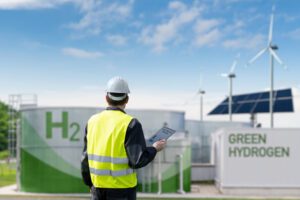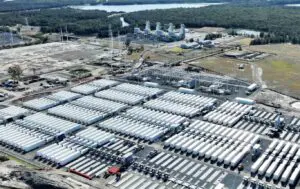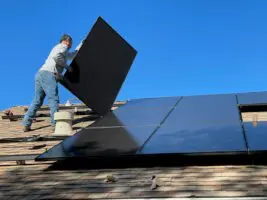The significant falls in electricity demand as a result of the Covid-19 lockdowns has led to record shares of variable renewable energy – wind and solar – in some European countries.
A new report from International Energy Agency notes that the “instantaneous” share of wind and solar (VRE) reached unprecedented levels of 63 per cent in Italy, 70 per cent in Austria (which normally relies on hydro), and 67 per cent in Belgium (normally a mix of coal and nuclear).
These levels are well above the maximum levels of wind and solar penetration achieved just a year ago, and are largely the result of the falls in electricity demand of between 10 and 35 per cent in affected regions.
“A combination of low electricity demand and the additional capacity coming online in 2019 and the first quarter of 2020, are leading to record high shares of infeed from variable renewables in electricity demand in some regions,” the IEA says.
 The levels cited are interesting because it is approaching the levels identified in the recent Renewables Integration Study by the Australian Energy Market Operator as likely to occur in Australia by 2025 under its central scenario, although it could reach 100 per cent in a “step change” scenario.
The levels cited are interesting because it is approaching the levels identified in the recent Renewables Integration Study by the Australian Energy Market Operator as likely to occur in Australia by 2025 under its central scenario, although it could reach 100 per cent in a “step change” scenario.
The share of wind and solar has only reached 50 per cent in Australia on a couple of 5-minute trading intervals, but AEMO says 75 per cent – and more – poses no great technical challenges, but it does require changes to market and regulatory settings.
The share of wind and solar hit a peak of more than 90 per cent in Germany, according to the IEA, although it already did so in 2019. Germany did set a new record low net load as a result of declining demand in the height of the Covid-19 lockdowns.
 California and Texas are also regions with high instantaneous shares of variable wind and solar, but the recent numbers have been little different from previous years, “showing that in some cases variability due to weather had stronger impacts than electricity demand reduction due to Covid-19”, the IEA said.
California and Texas are also regions with high instantaneous shares of variable wind and solar, but the recent numbers have been little different from previous years, “showing that in some cases variability due to weather had stronger impacts than electricity demand reduction due to Covid-19”, the IEA said.
And, as the IEA notes:
“Despite increasing VRE shares, security of supply has not been jeopardised during the current crisis, even in countries with very high penetration rates,” it writes.
It point to more “challenging conditions” in summer as the share of rooftop solar PV output might increase, leading to potential curtailment of renewables, but it notes that the crucial ancillary services normally provided by fossil fuel generators could be provided by solar PV and wind by implementing operational changes.
“Some countries are already actively doing this,” it says. “Covid-19 may require system operators to make use of balancing tools more frequently and for longer than in past summers, as is already stated by Great Britain ́s electricity system operator (National GridESO), in their April 2020 Summer Outlook.”
The IEA report noted that the rollout of large scale renewables will be hurt, but not halted, by the Covid-19 pandemic, and it will result in the first fall in new capacity additions in 20 years.
The anticipated 13 per cent fall in net additions of renewable electricity capacity compared to 2019 – largely due to delays in construction activity due to supply chain disruption, lockdown measures and social-distancing guidelines, and emerging financing challenges – still represents a 6 per cent increase in global installed capacity – more than the combined size of power systems in both North America and Europe.
In 2021, renewables are expected to show their resilience – the majority of the delayed projects are expected to come online, leading to a rebound in new installations.
“The resilience of renewable electricity to the impacts of the Covid-19 crisis is good news but cannotbe taken for granted,” said Dr Fatih Birol, the IEA executive director, in a statement accompanying the report.
“Even before the Covid-19 pandemic struck, the world needed to significantly accelerate the deployment of renewables to have a chance of meeting its energy and climate goals. Amid today’s extraordinary health and economicchallenges, governments must not lose sight of the essential task of stepping up clean energy transitions to enable us to emerge from the crisis on a secure and sustainable path.”
Birol said the spectacular growth and cost reductions of renewables over the past two decades have been a big success story for global energy markets, driven by innovation in both technology and policies. But continuing cost declines will not be enough to protect renewables from a range of uncertainties that are being exacerbated by Covid-19.
“This underlines the critical importance of getting stimulus packages and policy strategies right in order to ensure investor confidence in the months and years ahead.”
The IEA report said it was essential that governments provide policy predictability, which they could do through ambitious targets and objectives, reduce administrative barriers to renewables, and put renewables at the centre of stimulus packages.
This comes as Australia says its Covid-19 recovery plans will focus on supporting fossil fuel investment and infrastructure, and as key regulatory bodies announce delays to new rules and regulations that could remove barriers to new renewable and other smart technologies.









